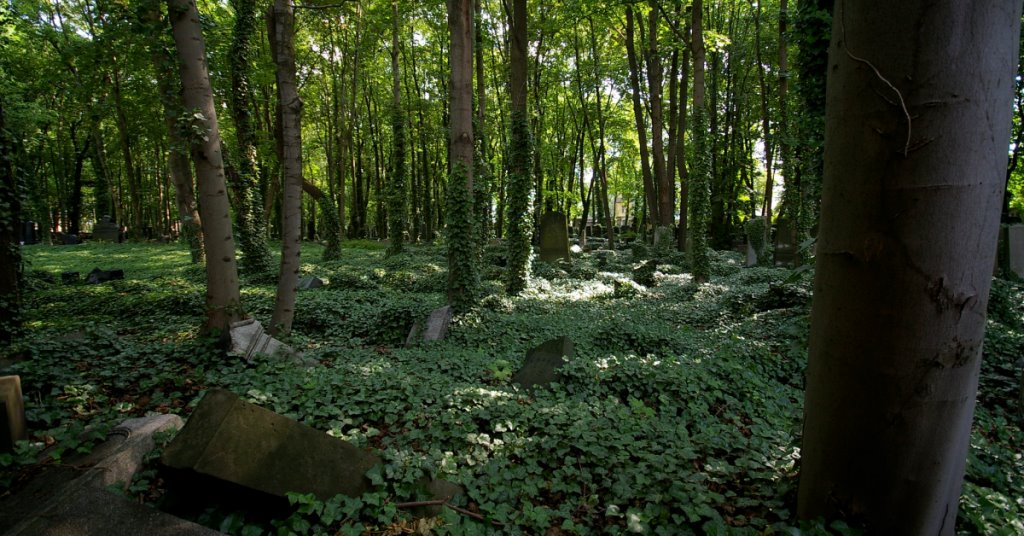Several weeks ago, I received a comment on this blog from Andrzej Mrowiński, a Pole who grew up in Barlinek, a small town in western Poland. Andrzej is researching the stories of Jewish citizens of Barlinek and their fate during the Second World War. At the time, Barlinek was called Berlinchen (Little Berlin) and it was here that Gert Drucker was born in 1930. Readers of this blog may recall that I wrote a post about Gert two years ago. His story intrigued me because my father had played with Gert as a child in the Rudolstädter Straße in Berlin. Gert passed away in 2012 and my father passed away in 2019 but I like to think that these two childhood friends met again on the other side.
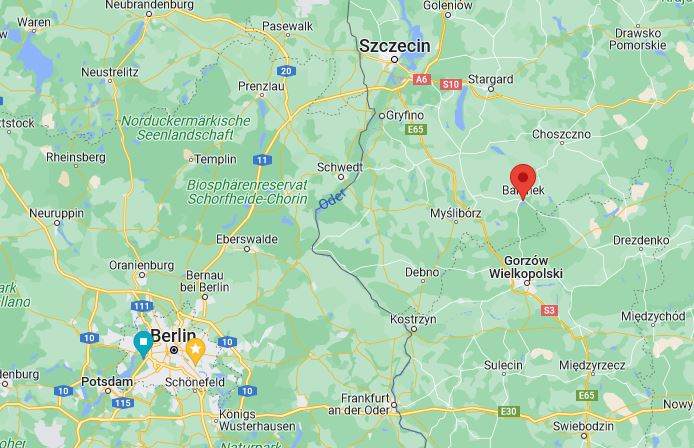
Andrzej published a book in 2019 entitled “Barlineckie Kamienie Pamieci – Historia Społeczności Żydowskiej” which translates as “Barlinek – Stones of Memory – A History of the Jewish Community”. Andrzej doesn’t speak much English and I don’t speak a shred of Polish but… with magic of Google Translate, we were able to communicate relatively well. Andrzej is planning to write a longer piece on Gert Drucker which should be ready in about six months. I will await the new book with bated breath! In the meantime, I ran several portions of Andrzej’s first book through Google Translate and Deepl and received his permission to reprint those bits here.
Stones of Memory
The book’s Table of Contents are:
Introduction
- Brief Historical Overview
- Extermination
- Searching for information
3.1 Berlinchen Online Family Book
3.2 Internet sources of information about the fate of the Jewish community - Victims of the Holocaust
- Famous Jewish people and families
5.1 The Lasker family
5.2 Emanuel Lasker – world chess champion
5.3 Maximilian Riess – founder of Gęsiareczka
5.4 The Grandauer family
5.5 The Messow family
5.6 The Neunstein family
5.7 The Drucker family
5.8 The Stensch family
5.9 Max WolffConclusion
Bibliography
I translated the Introduction in its entirety, portions of the Historical Overview and then focused on passages and sections that mentioned the Drucker family. I might one day attempt to translate more of the document, but it is a tedious process. The following passages are all translated with the power of Google Translate and Deepl. I have added some comments and clarification in italicized square brackets.
Introduction (from the book)
We often pass places that hide the memory of old times, and we notice that history is not sufficiently cherished here. There is a place in Barlinek that hides just such secrets unknown to most inhabitants.
We reach it by taking the recently opened recreational path from the Old Sawmill towards the lake. Then we have to go through the hill called Żydowska Górka. [I’ve learned that Żydowska is Jewish, so Jewish Hill] The route passes through the middle of the recently existing Jewish cemetery, which was established at the turn of the 18th and 19th century.
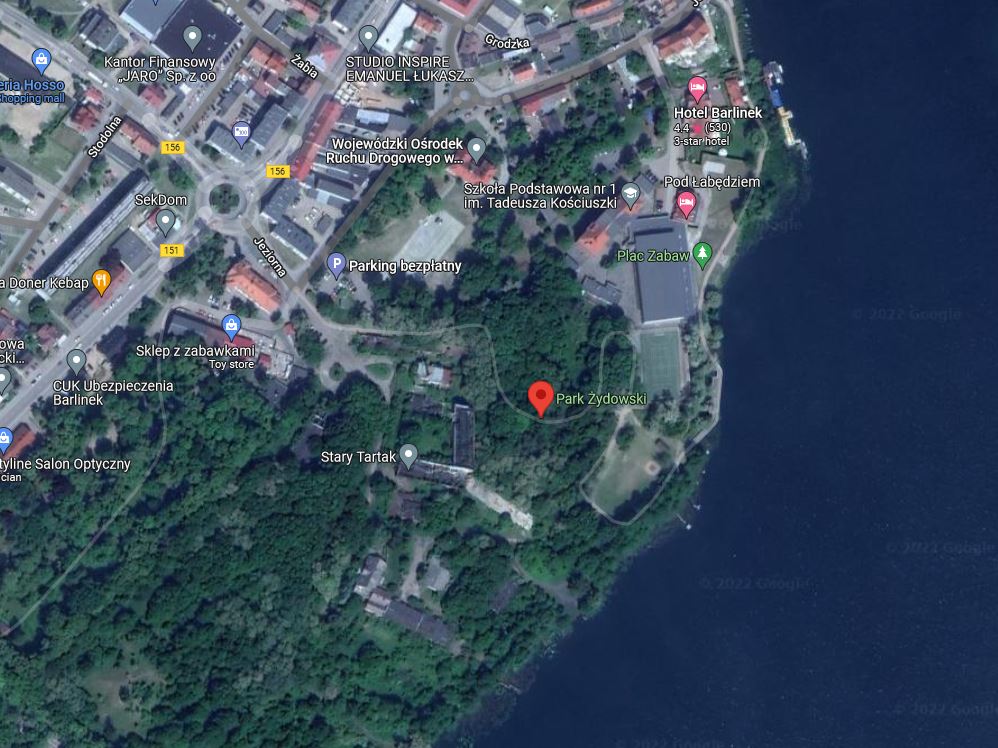
An information board informs us that there used to be a Jewish cemetery here.
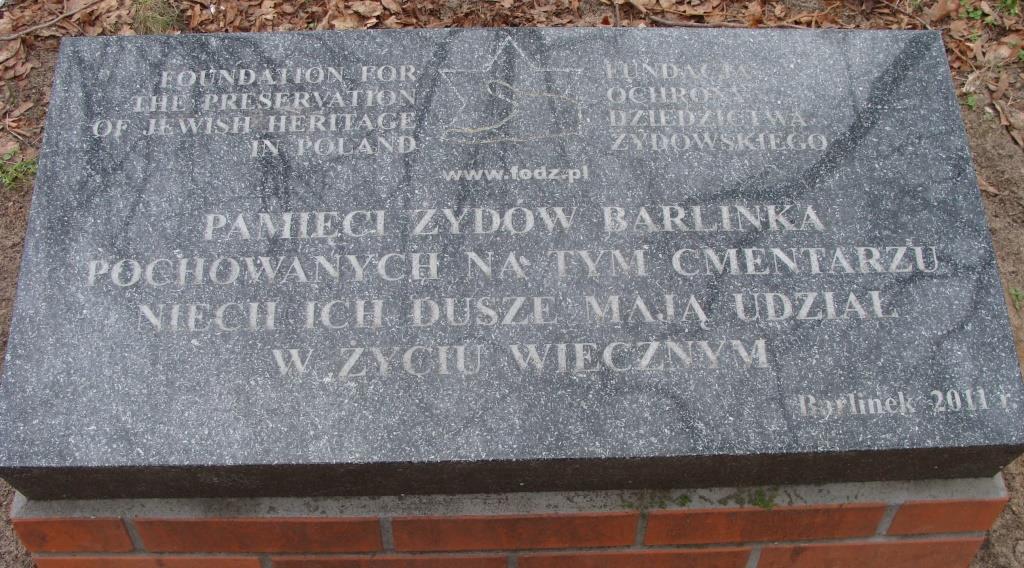
The plaque reads “In memory of Barlinek’s Jews buried in this cemetery. May their souls share in eternal life.”
(Photo courtesy of Andrzej Mrowiński)
Unknown to many, it is a special place hiding the memory of the old times. This place testifies that once in our town lived a small Jewish community, which nurtured its traditions. Unlike synagogues, which were destroyed in Germany during Kristallnacht, Jewish cemeteries survived the war basically unscathed. Also the Jewish cemetery in Barlinek was not destroyed during World War II. It was not until the post-war years that it was devastated or even physically liquidated.
This state of affairs is undoubtedly the responsibility of the Poles, i.e. the landlords of the area after 1945.
There were many reasons why Polish administration was not interested in maintaining the cemetery. First of all, the authorities of that time had a negative attitude towards all German legacy, which also included objects belonging to Jewish communities.
After the territories, where there had been no traces of Polishness for hundreds of years, were incorporated into Poland, efforts were made to bring back as many Slavic accents as possible and to erase the traces of the pre-war locality so that it would be Germanized as little as possible. In addition, the anti-Semitic campaign of 1968 and the breaking off of diplomatic relations with Israel by the then communist authorities led to the liquidation of traces of Jewish presence in the area.
The result of these negligent and deliberate actions was the physical liquidation of the pre-war Jewish cemetery in Barlinek. Tombstones with the Star of David, the symbol of the Jewish nation disappeared from the “Jewish Hill” or were covered with soil. From the “Jewish Hill” gravestones with the Star of David, the symbol of the Jewish nation, disappeared or were covered over with soil.
You will no longer see tombstones with a palm or a tree, whose drawing referred to the verse Psalm 92: “The righteous will flourish like a palm tree”, as well as tombstones with an engraved seven-branched candlestick, found basically only on tombstones of women.
The policy of obliterating Jewish traces in the history of our city has done its job. As a result, Barlinek residents knew practically nothing about the Jewish citizens who lived in the city. Only when the history of the city was being re-written after the transition did the citizens of Berlin hear about the famous Jewish chess player born in Berlinchen.
Since 1993, chess tournaments named after Dr. Emanuel Lasker Lasker and a book published in 1995 by Kazimierz Hoffmann and Zbigniew Miler “King from Barlinek” presenting the sports and scientific career of Emanuel Lasker, initiated the appearance of a Jewish thread in the history of the city.
When designing a pedestrian and bicycle route through “Jewish Hill” in 2010, it was impossible not to notice the existing Jewish cemetery there. In 2011, while building the walking route, the authorities of Barlinek, together with the Foundation for the Preservation of Jewish Heritage in Poland, cleaned up the area and commemorated the Jewish inhabitants with a memorial plaque.
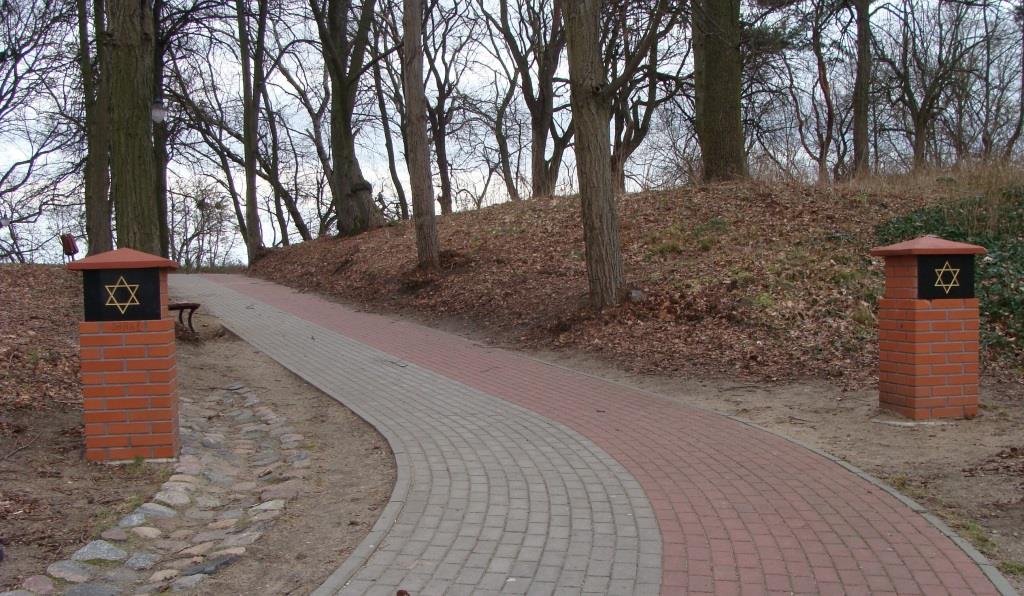
In order to get to know this part of the history of our region I decided to deepen the information about the Jewish community living in Barlinek before the war. The scarce state of knowledge about Jews living in Barlinek and poor source documentation made the task of bringing this group closer was difficult and complicated. This was made even more difficult by the fact that most of the Jewish residents of Berlinchen lost their lives during World War II and left behind no accounts.
In describing the fate of the citizens of Jewish origin connected with Berlinchen, I have tried to present the stories of different families and to show it as a story not of anonymous people, but as the story of citizens of the city, known by name, who not only made their mark on the history of the city, but also became more widely known as global citizens.
1. Brief Historical Overview (from the book)
[I have not translated this chapter in its entirety but dipped into it for the section on Drucker.]
… (page 15)…
The culmination of the persecutions took place on the night of November 9-10, when, according to the instructions of Goebbels’ instructions, a pogrom against Jews was carried out. On that day 91 Jewish people were killed. of Jewish nationality, several hundred synagogues and over seven thousand shops were burned or destroyed.
Almost all Jewish cemeteries were desecrated. This event went down in history as “Kristallnacht” because of the large number of shards of glass from destroyed Jewish homes and stores. Thirty thousand Jews, mostly men, were arrested that night. They were imprisoned in newly established concentration camps, where over the next three months, one in ten of them lost their lives.
Among those arrested were Berlinchen dentist Benno Drucker and the son of Berlinchen-born Helena Blumenhein, Ernst Alfred Blumenhein.
From that day on, the fascist authorities applied further repressive measures against the Jews, the aim of which was to force them to emigrate as soon as possible. In order to hasten their decision to leave Germany, Jews were made uncomfortable in their daily lives. Jewish children were forbidden to study together with their Aryan peers.
In Hermann Göring’s speech on January 24, 1939, one could hear the assurance of the creation of a central office to support by all means Jews from Germany. On the condition that Jews leave Germany, for example, those imprisoned during Kristallnacht were released from concentration camps.
… [several more pages]
2. Extermination (from the book)
[I have not translated this chapter in its entirety but dipped into it for the section on Drucker.]
… (page 22)…
Between 1943 and 1944, 33 railroad transports left Berlin for Auschwitz. The largest of these, which set out on March 2, 1943, contained 1,758 Jews. Four transports left Berlin four days later, between March 1 and 4, with a total of 6,368 Jews sentenced to death in Berlin. These transports also included the Haymann family living in Berlinchen, which was broken up on their last journey. Margarete left on March 1, her daughters Marie Rose and Hilde on March 2, and her husband Paul Heymann on March 4.
On the March 2 transport, another former Berlinchen resident Willy Marcus also travelled. In the transports to the Auschwitz extermination camp in 1943, one finds four other former Berlinchen residents. They are: Gerda Jüdel, Benno and Else Sieburth, and Herbert Friedemann.
Transports to the extermination sites departed from almost every major city in Germany. From Munich alone, nine large transports left during the war for Kovno, Riga, Izbica, Piaski, Krasiczyn, and Auschwitz, and almost 30 smaller ones to Terezin. Deportation transports also came from areas occupied by Germany. From France, mainly from the Drancy camp, from March 27, 1942 to August 11, 1944, 78 transports of Jews left for the death camps. Among them No. 50, which left Drancy for Majdanek on March 4, 1943, was Benno Drucker, a Jewish dentist from Berlinchen.
….. [several more pages]
4. Victims of the Holocaust (from the book)
[I have not translated this chapter in its entirety but dipped into it for the section on Drucker.]
… (page 34)…
Benno Drucker was born in the village of Bartin (Barty near Koszalin) on 10th December 1899. [Koszalin is on the Baltic Coast about halfway between Szczecin (formerly Stettin) and Gdańsk (formerly Danzig).] After completing medical studies. he and his wife Adela settled in Berlinchen. The couple moved to Bahnhofstrasse (currently Aleja 1 Maja – 1st of May Street) in a three-storey tenement house. There they rented an apartment on the second floor, where they established a large dental practice.
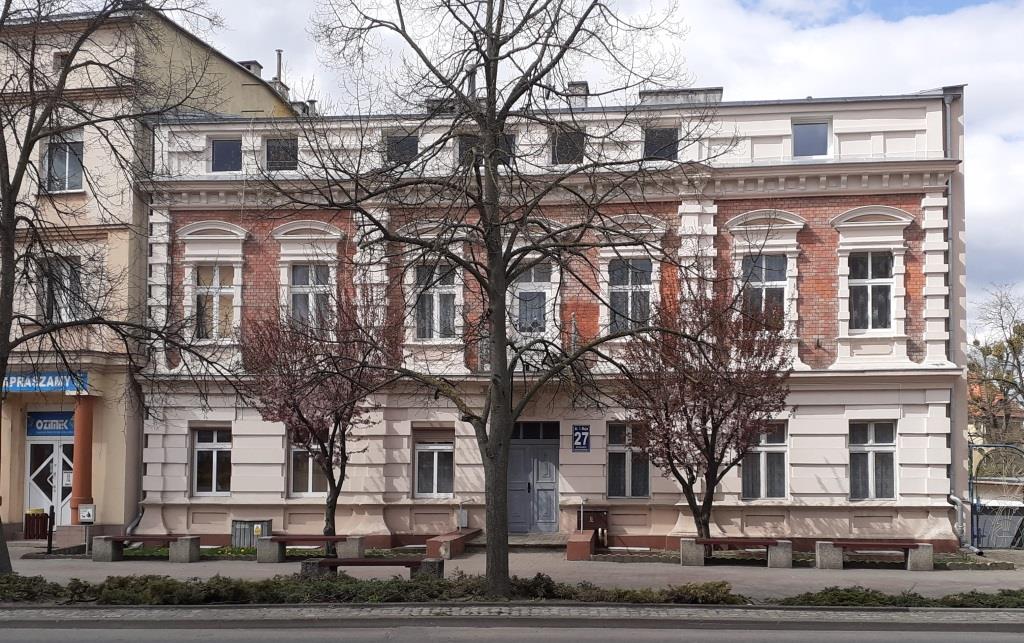
On February 5, 1930 their son Gerd was born. The happiness of the young couple did not last long. Times were hard. The dentist’s office was shunned by the inhabitants.
Benno Drucker was aware of the dangers of the times in which he had to live and therefore, before the war broke out, he bought a property in the southern part of Brazil, in the state of Santa Catarina, in the town of Blumenau, from a German who lived in Brazil and wanted to return to his country. However, escaping from the Nazis and going to South America was not easy.
After Kristallnacht Benno was arrested and imprisoned in Sachsenhausen. [Josef Jakobs was also imprisoned there. I wonder if the two met?] He was released on January 6, 1939 and from that point onwards tried to hide from the authorities. He obtained false documents and, with their assistance, he and his family left Germany, first for Belgium and then for France. After the German occupation of France, Benno and Adela were placed in a transit camp for Jews in Drancy and their son was placed in an orphanage. Benno was killed in the concentration camp at Majdanek, where he was sent from Drancy on March 4, 1943. Adela and Gerd survived the war.
….. [several more pages]
5.7 The Drucker Family (from the book)
[I have translated this section in its entirety.]
… (pages 89-91)…
In the second decade of the twentieth century a young dentist, Benno Drucker, came to Berlinchen after medical studies. He was born on December 10, 1899 in the village of Bartin (Barty near Koszalin).
He lived with his wife Adela on Bahnhofstrasse (currently Aleja 1 Maja) in a three-story tenement house. There they rented an apartment on the second floor, where they arranged a large dentist’s office. On February 5, 1930 their son Gerd was born. The happiness of the young couple did not last long. Times were hard. The dentist’s office was shunned by the inhabitants, its only patients were Jews, which did not allow them to earn a decent living. When their son turned six, his parents enrolled him in the local school. However, the young Drucker was treated with hostility in his class. His schoolmates made it clear to him that they did not tolerate a Jew in their group. Although at the beginning Gerd did not complain to his parents about the way his peers teased him, his parents noticed it and decided that after completing the second grade he would continue his education in Berlin. He was sent to his grandparents on his father’s side, who lived in the German capital, and placed in a Jewish educational institution. [This explains why Gert/Gerd was living with his grandparents in the Rudolstädter Straße and why his mother later lived at a different address in Berlin.]
The eight-year-old Gerd thus left his hometown of Berlinchen in 1938, never to return.
For a young boy, this forced separation from his parents and education at a Berlin school, was not easy. Not surprisingly, he did not recall this period of his life very well. He mainly remembered the various humiliations he had experienced at school and the fact that he was constantly beaten.
Benno Drucker was aware of the dangers of the times in which he had to live and so, before the outbreak of war, he bought a property in the southern part of Brazil, in the state of Santa Catarina, in the town of Blumenau, from a German who lived in Brazil and wanted to return to his country. Escaping from the Nazis and going to South America was not easy, however.
The borders began to close to German Jews wishing to leave the country, and the reason for this was not always the German ban, but increasingly the lack of funds for the long journey and the difficulty of obtaining permission from the destination country to come.
After Kristallnacht Benno was arrested and imprisoned in Sachsenhausen.
He was released from the camp on January 6, 1939. After regaining freedom, he moved with his wife to Berlin and started to hide his origins. In the middle of 1942 he was tracked down by the Gestapo. Gerd witnessed the secret police search an apartment in Berlin’s Wilmersdorf district looking for his parents and he warned them of the threat of arrest and deportation. The Druckers had no other choice but to get false documents and with their help try to save their lives by leaving Germany.
The escape from Germany was successful. They reached first Brussels and then France.
The Druckers’ intention was to get to neutral Switzerland using false documents. However, they were arrested by the French who collaborated with the Germans.
Benno was in a transit camp for Jews in Drancy, while Adela and Gert were sent to an internment camp in Nexon, and later to Camp de Rivesaltes. Eventually, thanks to a children’s aid organization (Dzieło Pomocy Dzieciom or OSE – Oeuvre de Secours aux Enfants) Gert was sent to an orphanage by the sea and later to the 17th century Château du Masgelier in Creuse where efforts were made to hide Jewish children. Gerd, who was twelve years old, was very upset by the separation from his parents. He still remembers a letter written in French which his father sent to him in 1943.
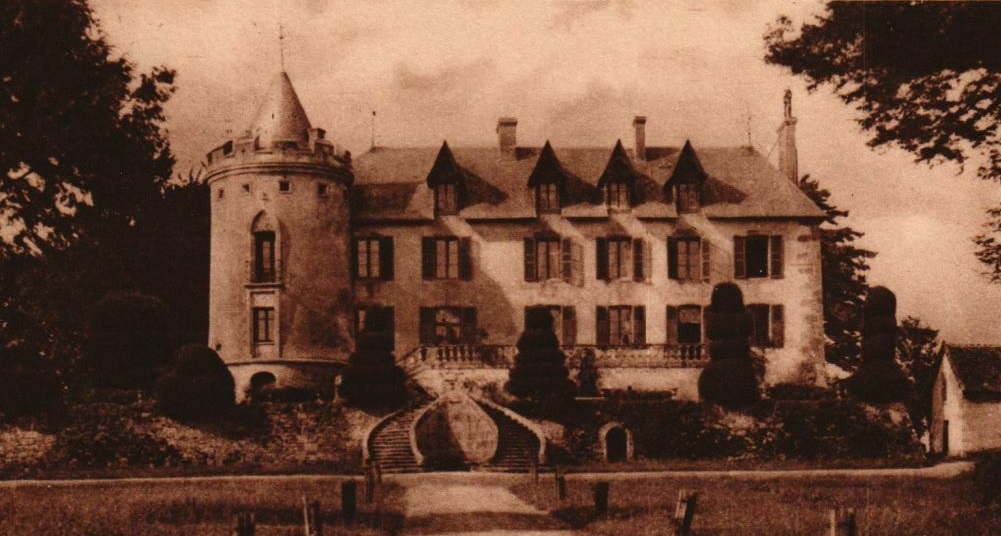
In the same year, on March 4, Benno was sent to the concentration camp in Majdanek, where he was murdered.
Gerd spent the rest of the war hiding his Jewish origin in an orphanage in the south of France in Rivesaltes. The liberation found him in Saint-Gaudens (now Sent Gaudenç) in the Pyrenees.
His mother Adela also survived the war. After the war, they found refuge with Walter Drucker, Benno’s younger brother and his wife who lived in France.
In 1946, after obtaining a Brazilian visa, they went to Brazil where the property Benno had bought earlier was waiting for them. They then moved to Curitiba.
The young and ambitious Gerd, having mastered the Portuguese language, started his studies and professional career. Later he graduated in psychology at the Pontifical Catholic University Paraná and began working as a psychologist in Curitiba. In 1975 he married Therezinha Briski, the granddaughter of a Brazilian and a Pole. He is still living with his wife, enjoying after his retirement a great recognition in the place where he lives. [Gerd passed away in early 2020.]
….. [several more pages from different sections]…
Conclusion (from the book)
[I have translated this chapter in its entirety.]
This publication was created out of the need to discover unknown or forgotten historical facts about the region in which we live. I have tried to make my study of the history of Jews who once lived in Barlinek more popular than scientific.
My main goal was to restore the memory of the Jewish community that had lived in the area for centuries, but also to draw attention to different perceptions of the of the extermination of the Jews. The Germans’ point of view on this issue differs significantly from the way the Poles view the Holocaust.
The former, by their electoral decision, contributed to the seizure of power by the fascist National Socialist NSDAP party, and thus were responsible in conscience for all subsequent actions against the Jews. This does not mean, however, that all Germans agreed with the authorities’ decision and did not notice the unjust treatment of their Jewish neighbors. We would be greatly mistaken to blame all Germans for the crimes of the Nazis. Their indifference to the fate of their fellow Jews resulted in large part from the discipline and obedience to authority characteristic of German society, but also from simple fear. The average German observing the deportations to the east probably thought to himself something like this: “They are sending these poor Jews of ours somewhere to the east.
The deportation action was also regarded in German Jewish circles as harmful and inhumane. Nevertheless, under pressure from those in power, the Jewish community prepared and handed over to the Gestapo lists of its followers, who were then sent east. After all, no one knew what their fate would be there. It was believed that it could not be worse than here in Germany. It was commonly believed that they were going to labor camps, but there were also rumors spread that they were going to areas prepared in the east for a Jewish state, where life would go on as in the kibbutz.
How differently we Poles look upon the extermination of Jews. In Poland, there were huge Jewish ghettos (I remind you that there were no such ghettos in Germany), the number of Jews was much greater. In Poland there was also a great war terror directed against Poles occupied by the Germans. It is enough to mention that for any help to Jews was punishable by death for the whole family. Although awareness of the fate of one’s Jewish brethren was undoubtedly greater in Poland than in Germany, Polish society under German occupation, with a government in exile, was unable to change anything.
The points of view on the Holocaust are therefore different, but this does not mean that what took place in the twentieth century cannot be viewed together: Germans, Jews, and Poles.
The horrible genocide of one social group committed during World War II by the German state under Adolf Hitler and the NSDAP cannot be forgotten.
We must talk about it so that such times never happen again in history.
We live today in a city in which probably (but I cannot write this with certainty) there are no Jewish inhabitants, but this does not release us from the obligation to remember the Jews who once lived in our city. They occupied various social positions, from the poor to local doctors, traders and industrialists.
In presenting the fate of the Jews living in the former Berlinchen, who also became famous as citizens of the world, I would like to bring them back to memory. I have written about Gunter Demnig, the artist who initiated the placing of brass plaques in the cobblestones on them the names of the victims of the Nazi era, called “memorial stones [the Stolpersteine]. His intention was to commemorate the people who lived near such plaques.
I would very much like.., for this publication to be such a collection of “Barlinek’s memorial stones”.
We have to do it not only for historical reasons, but also to erase the sin of destroying traces of the Jewish community’s existence in our land.
I am thinking here of the Jewish cemetery. There you would find plaques with their names, dates of birth and death.
Unfortunately, they no longer exist.
Summary
I commend Andrzej Mrowiński for researching and documenting the stories of the former Jewish citizens of Berlinchen. As Andrzej notes, their stories are critically important if we are not to repeat the mistakes of the past. One would think that no one could ever forget the Holocaust. And yet… in 2020, a nationwide survey of American millennials and Generation Z found a shocking lack of awareness around the Holocaust.
The survey, touted as the first 50-state survey of Holocaust knowledge among millennials and Generation Z, showed that many respondents were unclear about the basic facts of the genocide. Sixty-three percent (63%) of those surveyed did not know that 6 million Jews were murdered in the Holocaust, and over half of those thought the death toll was fewer than 2 million. Over 40,000 concentration camps and ghettos were established during World War II, but nearly half of U.S. respondents could not name a single one. (From NBC News)
Dachau, Treblinka, Theresienstadt, Sobibor, Sachsenhausen, Auschwitz, Bergen-Belsen… shocking that nearly 50% of US respondents could not name one of these places. I would think that these names would be seared into our collective consciousness but apparently not.
It’s not just the Americans. A 2021 national study of Holocaust knowledge and awareness in the United Kingdom found that 52% of all respondents did not know that six million Jews were murdered during the Holocaust with 22% thinking that two million or fewer Jews were killed. And the numbers are no better in Canada, much as we like to think we are more progressive than the Americans.
I am grateful to Andrzej for lighting this torch and carrying the stories of these people into the future. I know that when I take my niece to Germany (eventually – after Covid) that we will visit at least one of the concentration camp memorial sites. She will learn. She will know. We will not forget.
Sources
Andrzej has written an article for the Barlinek24.PL site – it has some old photographs of the Jewish Hill
Here’s another link to the Barlinek24.PL site which has info on his book “Barlineckie Kamienie Pamieci – Historia Społeczności Żydowskiej”
This link has a list of all the articles Andrzej has written for Barlinek24.PL site – there are quite a few!
Header Image – The Jewish Cemetery in Schönhauser Allee, Berlin – from Flickr
